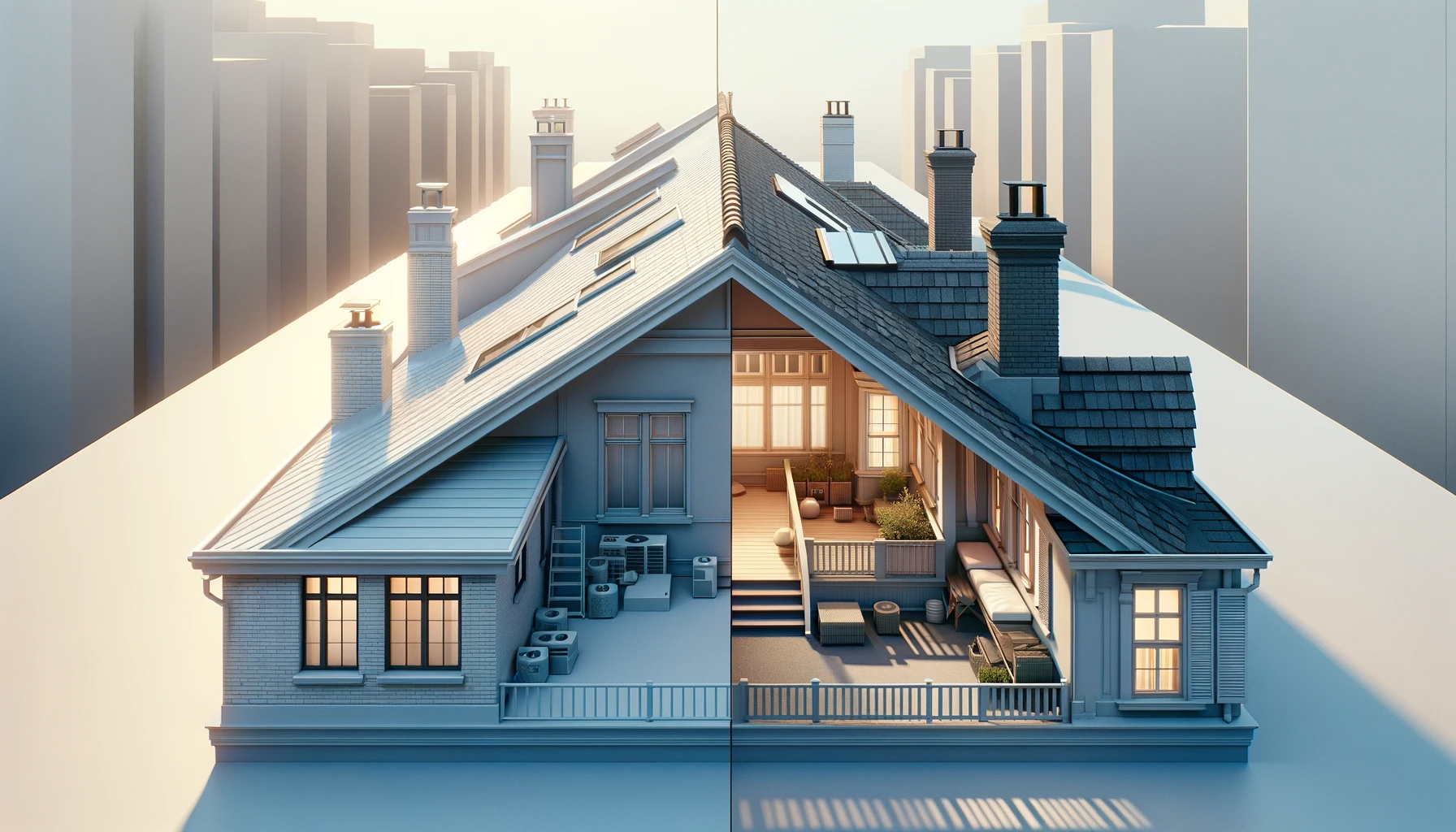Choosing the right roof for your building is a decision that carries significant weight. It all boils down to two main options: a pitched roof or a flat roof. A straightforward choice between these two designs can greatly impact your building’s functionality, appearance, and overall value.
Generally, pitched roofs are common in homes, while flat roofs often grace the tops of businesses. But why this distinction? What makes one preferable over the other?
Let’s delve into the practicalities of pitched versus flat roofs as we outline their pros and cons. With this information, you’ll be equipped to make a well-informed decision based on your budget and vision for the building.
What is a Flat Roof?
Flat roofs are mostly characterized by their nearly horizontal or low slope design. Despite its seemingly level surface, a well-designed flat roof usually incorporates a subtle slope.
They usually have a gentle slope of less than 2% to facilitate effective drainage and prevent water pooling. This slope can be imperceptible to an untrained eye but remains efficient at directing precipitation toward the building’s gutter system.
The flat roofing style is commonly employed in modern residential constructions, industrial facilities, and commercial buildings.
In most cases, flat roofs are constructed with materials such as built-up roofing, modified bitumen, single-ply membranes, and spray polyurethane foam (SPF).
Pros
- Flat roofs offer additional usable space that can be used for A/C units, rooftop gardens, or decks.
- Flat roofs require lower installation costs than pitched roofs due to reduced material and labor requirements.
- The clean, minimalist lines of flat roofs align with the contemporary architectural trend that gives buildings a sleek and stylish appearance.
Cons
- Flat roofs generally last around 10 years, considerably shorter than pitched roofs.
- Flat roofs require frequent maintenance, especially in regions with heavy rainfall or snow.
- Flat roofs struggle to shed rain or snow efficiently, so there’s a high risk of water accumulation.
What is a Pitched Roof?
A pitched roof is defined by its steep incline that typically ranges from 25 to 47.5 degrees. This design forms a triangular shape, allowing efficient water, snow, and debris drainage.
Unlike flat roofs, pitched roofs create extra living space that often features attics. They are usually constructed with asphalt shingles, clay or concrete tiles, and wood shingles or shakes.
As a result of their construction form and materials, pitched roofs offer both functionality and a distinctive aesthetic. The two sloping parts of a pitched roof meet at an angle in the center ridge, contributing to the classic triangular silhouette atop many residential homes.
Pros
- Pitched roofs exhibit exceptional durability. They can last for 20 years or more with proper installation and maintenance.
- The steep slope of pitched roofs facilitates efficient drainage, so there’s less chance of water pooling and risk of leaks.
- Pitched roofs demand less maintenance due to their design
- Pitched roofs offer better insulation
- Pitched roofs provide a timeless, homey appeal that seamlessly blends into residential neighborhoods.
Cons
- Pitched roofs can be 3-4 times more expensive to install or replace than flat roofs due to increased material and labor requirements.
- Unlike flat roofs, investigating potential issues on a pitched roof is unsafe without hiring a shingle roof expert.
- Local building regulations may limit the height and style options for pitched roofs, impacting architectural design choices.
Flat Roof vs. Pitched Roof – Which is Better?
Below are some factors you can consider for making this decision.
-
Cost
When deciding between a flat roof and a pitched roof, cost is a crucial factor that varies based on factors like building size, roofing materials, design complexity, and local labor rates.
Generally, constructing pitched roofs tends to be more expensive than flat roofs. However, it’s essential to consider long-term maintenance costs.
To determine the most cost-effective roofing solution for your home, seek estimates from experienced contractors or roofing professionals. Their expertise will allow you to get accurate cost assessments tailored to your project’s requirements.
They can guide you toward an informed decision that aligns with your budget and goals.
-
Design
Flat and pitched roofs exhibit distinct designs that contribute to a home’s overall aesthetic in different ways. A flat roof embraces a modern and contemporary architectural style characterized by sleek lines. Hence, it offers a minimalist appearance.
In contrast, pitched roofs exude a traditional and classic feel that evokes a timeless look often associated with cottages and Victorian homes. The gentle slope of a pitched roof communicates comfort and nostalgia.
This makes it particularly suitable for those who appreciate a more traditional or homely appearance.
When choosing between the two, consider how the design aligns with the desired aesthetic and how it complements the existing style of the building.
-
Insulation
When it comes to insulation, pitched roofs typically outperform flat roofs. The steep slope of a pitched roof allows for thicker and more substantial insulation materials that result in a higher R-value.
However, advancements in roofing technology offer solutions for both flat and pitched roofs. You can consider installing a roofing component that helps enhance ventilation and insulation.
This innovative approach creates a natural cooling system within your home.
Conclusion
Choosing between a flat roof and a pitched roof involves weighing various factors such as cost, design, and insulation. While each option has merits, finding the perfect roofing solution often requires expert guidance.
If you are unsure which roof type to install, You can trust us at TheRoofPro for professional insights and reliable services. Contact us today to explore our expertise and elevate your roofing journey.


